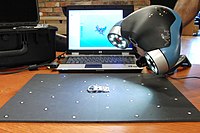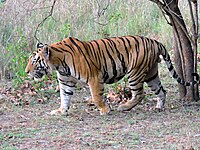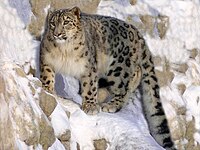
An empirical evaluation of camera trapping and spatially explicit capture‐recapture models for estimating chimpanzee density
Sign Up to like & getrecommendations! Published in 2017 at "American Journal of Primatology"
DOI: 10.1002/ajp.22647
Abstract: Empirical validations of survey methods for estimating animal densities are rare, despite the fact that only an application to a population of known density can demonstrate their reliability under field conditions and constraints. Here, we… read more here.
Keywords: camera; capture recapture; camera trapping; density ... See more keywords

Arboreal camera trapping sheds light on seed dispersal of the world’s only epiphytic gymnosperm: Zamia pseudoparasitica
Sign Up to like & getrecommendations! Published in 2022 at "Ecology and Evolution"
DOI: 10.1002/ece3.8769
Abstract: Abstract Epiphytic lifestyles have evolved independently in ecologically, morphologically, and taxonomically diverse plant species. Although this adaptation is widespread among angiosperms, it is only known to have arisen in a single gymnosperm species, Zamia pseudoparasitica… read more here.
Keywords: zamia pseudoparasitica; ecology; arboreal camera; camera trapping ... See more keywords

Estimating mammalian species richness and occupancy in tropical forest canopies with arboreal camera traps
Sign Up to like & getrecommendations! Published in 2017 at "Remote Sensing in Ecology and Conservation"
DOI: 10.1002/rse2.35
Abstract: Large and medium-bodied rainforest canopy mammals are typically surveyed using line transects, but these are labour intensive and usually ignore nocturnal species. Camera traps have become the preferred tool for assessing terrestrial mammal communities, but… read more here.
Keywords: camera trapping; camera traps; line transects; camera ... See more keywords

Camera trapping mammals in the scrubland’s of the Cape Floristic Kingdom—the importance of effort, spacing and trap placement
Sign Up to like & getrecommendations! Published in 2017 at "Biodiversity and Conservation"
DOI: 10.1007/s10531-017-1448-z
Abstract: As a non-invasive monitoring method camera traps are noted as being an effective, accurate and rapid means of compiling species richness estimates of medium to large terrestrial mammals. However, crucial elements of camera trap survey… read more here.
Keywords: camera trapping; species richness; camera; placement ... See more keywords

Quantifying wildlife-livestock interactions and their spatio-temporal patterns: Is regular grid camera trapping a suitable approach?
Sign Up to like & getrecommendations! Published in 2020 at "Ecological Indicators"
DOI: 10.1016/j.ecolind.2020.106565
Abstract: Abstract Camera trapping use has increased significantly in ecological studies in recent decades due to its ability to register information about cryptic and/or elusive species and, more recently, due to its ability to derive population… read more here.
Keywords: information; camera trapping; study; gps ... See more keywords

Quantifying the bias in density estimated from distance sampling and camera trapping of unmarked individuals
Sign Up to like & getrecommendations! Published in 2017 at "Ecological Modelling"
DOI: 10.1016/j.ecolmodel.2017.02.007
Abstract: Population size estimates are an integral part of any species conservation or management project. They are often used to evaluate the impact of management intervention and can be critical for making decisions for future management.… read more here.
Keywords: distance sampling; density; camera trapping; sampling camera ... See more keywords

Baiting improves wild boar population size estimates by camera trapping
Sign Up to like & getrecommendations! Published in 2019 at "Mammalian Biology"
DOI: 10.1016/j.mambio.2019.07.005
Abstract: Abstract In the last decade, camera trapping has become a widespread technique for wildlife monitoring. Although baits or attractants are commonly used to increase the likelihood of encounter, this practice has been criticised because of… read more here.
Keywords: population size; camera trapping; wild boar; population ... See more keywords

Estimating wildlife activity curves: comparison of methods and sample size
Sign Up to like & getrecommendations! Published in 2018 at "Scientific Reports"
DOI: 10.1038/s41598-018-22638-6
Abstract: Camera traps and radiotags commonly are used to estimate animal activity curves. However, little empirical evidence has been provided to validate whether they produce similar results. We compared activity curves from two common camera trapping… read more here.
Keywords: camera trapping; size; activity curves; sample size ... See more keywords

Camera trapping expands the view into global biodiversity and its change
Sign Up to like & getrecommendations! Published in 2023 at "Philosophical Transactions of the Royal Society B: Biological Sciences"
DOI: 10.1098/rstb.2022.0232
Abstract: Growing threats to biodiversity demand timely, detailed information on species occurrence, diversity and abundance at large scales. Camera traps (CTs), combined with computer vision models, provide an efficient method to survey species of certain taxa… read more here.
Keywords: trapping expands; camera trapping; global biodiversity; biodiversity ... See more keywords

Camera-trapping estimates of the relative population density of Sympetrum dragonflies: application to multihabitat users in agricultural landscapes
Sign Up to like & getrecommendations! Published in 2023 at "PeerJ"
DOI: 10.7717/peerj.14881
Abstract: Although camera trapping has been effectively used for wildlife monitoring, its application to multihabitat insects (i.e., insects requiring terrestrial and aquatic ecosystems) is limited. Among such insects, perching dragonflies of the genus Sympetrum (darter dragonflies)… read more here.
Keywords: application multihabitat; density; insects; camera ... See more keywords